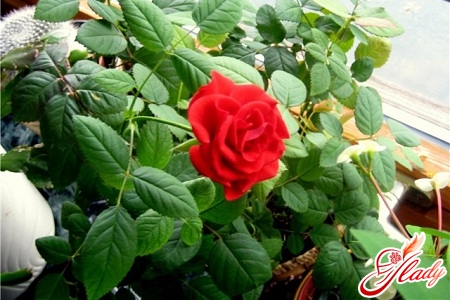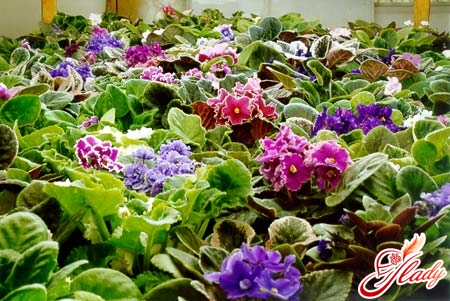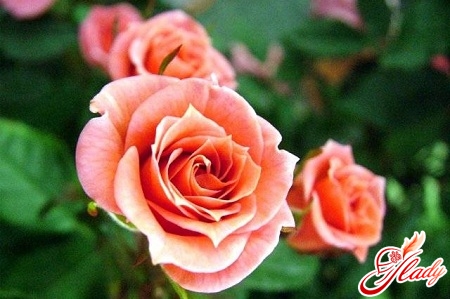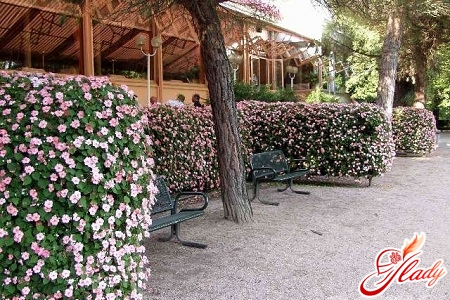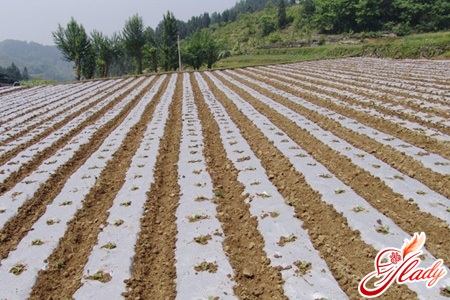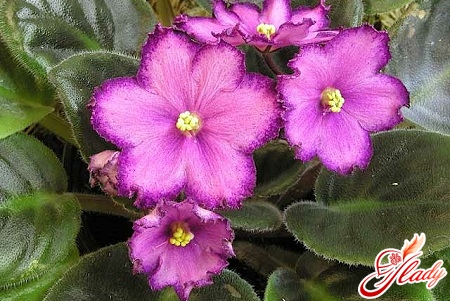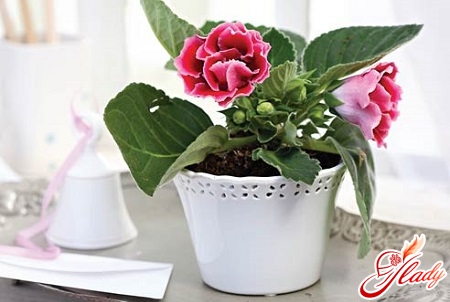 Real flower growers can't ignore itsuch bright and beautiful representatives of indoor plants, which are gloxinia. Their large buds delight owners with their blossoming appearance once or twice a year and in shape really resemble a bell with delicate velvety petals. Undoubtedly, growing gloxinia is a labor-intensive process that requires patience. But as a result, you will get a real pearl of your home greenhouse. And now a little general information about what this plant is in nature. It should be noted that gloxinia in the plant classifier refers to tropical perennial herbs and semi-shrubs. They have a root system in the form of scaly tubers. Their stem is straight, the leaves are located opposite each other. Flowers are quite large single buds that emerge from the axils. The distribution area of this plant is almost the entire territory of America. In the natural environment, representatives of the described family can be found in rocky areas, on the banks of rivers and in shady forests.
Real flower growers can't ignore itsuch bright and beautiful representatives of indoor plants, which are gloxinia. Their large buds delight owners with their blossoming appearance once or twice a year and in shape really resemble a bell with delicate velvety petals. Undoubtedly, growing gloxinia is a labor-intensive process that requires patience. But as a result, you will get a real pearl of your home greenhouse. And now a little general information about what this plant is in nature. It should be noted that gloxinia in the plant classifier refers to tropical perennial herbs and semi-shrubs. They have a root system in the form of scaly tubers. Their stem is straight, the leaves are located opposite each other. Flowers are quite large single buds that emerge from the axils. The distribution area of this plant is almost the entire territory of America. In the natural environment, representatives of the described family can be found in rocky areas, on the banks of rivers and in shady forests.
"Wild parents" of a house plant
Now a flower of mesmerizing beautyGloxinia can be admired by each of us if we express a desire to settle this exotic guest among the rest of the specimens of our green collection. The most popular are several variations of these velvety bells. But all of them were obtained by crossing two main types of gloxinia - royal and beautiful. Agree, even the dictionary combination of these names in itself hints at a very effective result of selection. Scientists really managed to breed unusually beautiful varieties of the plant. What are the so-called "parents" of these popular indoor beauties? Royal gloxinia (or Gloxinia regina) is a herbaceous plant. It has thickened stems, the length of which is within ten centimeters, and four to six pairs of oval heart-shaped leaves up to twenty centimeters long. The main color of the leaves is dark green, and a light silvery sheen is easily visible along the veins. The buds resemble drooping bells in shape, they are located on long legs and reach seven centimeters in diameter. Royal gloxinia blooms in the summer, and at the end of the active period, its above-ground parts dry up and fall off. In winter, it is dormant, and in the spring it produces new shoots. Beautiful gloxinia (or Gloxinia speciosa) is also a type of herbaceous plant. It has long, broadly oval, tapering at the ends and uniformly colored green leaves with short petioles. The shape and shade of the buds depend on the variety of the plant. There are flowers with a simple and frilled bend of the corolla, drooping or, conversely, directed upwards, red with white, purple, soft pink, blue, violet, and so on.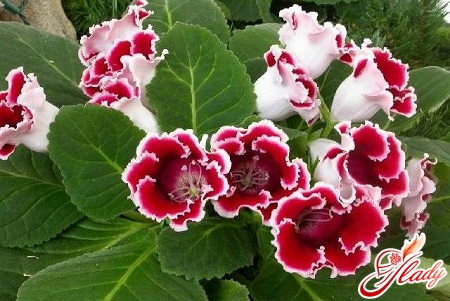
Features of flowering and gloxinia disease
If your plant is grown correctly withif you follow the necessary conditions for caring for it, then after the appearance of the fourth pair of young leaves, you can see the buds. Their quantity and quality directly depend on the size of the tuber and the main points of the plant's maintenance. If you have become the happy owner of hybrid varieties "Brocade" or "Avanti" grown by yourself, then you will probably be able to admire their repeated flowering again, if the first occurred at an early stage of the plant's development. To do this, cut off the stem and leaves, leaving only a two-centimeter shoot. Soon you will see that the gloxinia will give lateral shoots of the so-called second growth. They form bell-shaped buds of a smaller size than it was the first time. It should be noted that not all varieties of this plant have repeated flowering. Most often, owners of different types of gloxinia are faced with the fact that the plant is affected by numerous diseases. The main and most dangerous of them include:
- blight
- decay of a tuber
- fusariosis
- blackleg
- powdery mildew
- pythoid and gray rot and other diseases of fungi, viruses, infections and bacteria
Many diseases are caused by improper watering,over-watering of the soil or its contamination. Flowers often become victims of parasitic insect pests - mites and thrips. As preventive and therapeutic measures, flower growers recommend using drugs called phytosporin and fundazol. But it is equally important to adhere to a number of mandatory rules for the maintenance of gloxinia. It is not recommended to place several flowerpots with plants in one tray at once. Flowers require diffused light and direct sunlight is absolutely contraindicated. Also take care of the correct distance between adjacent plants. The specimens you have should not shade each other; they need free access to fresh air. In this simple way, you can prevent quite dangerous diseases, for example, avoid blackening of the leg. There are also a number of recommendations for the arrangement of the soil in which gloxinia grows. It should have a peaty base and allow air and moisture to pass through well. Before planting the plants, the soil for them should be steamed or treated with phytosporin. This will help destroy most bacteria, infections and viruses that cause the main diseases of gloxinia. Remember that watering should be done evenly over the entire soil surface, without allowing flooding or overdrying. Significant temperature fluctuations, cold or, conversely, heat, also have a negative effect on the plant, weaken it and provoke various diseases. The key to successful breeding of gloxinia at home is healthy planting material and keeping flower collections clean.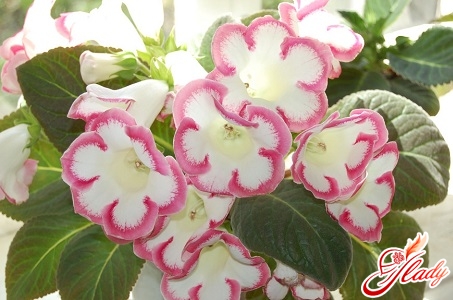
Pests that can kill gloxins
The plant with velvet bells is verythrips and mites love them. These pests can be of several varieties, so it is necessary to know what signs indicate damage by a specific parasite. The cyclamen mite is so small that it can only be seen under a microscope. Its accumulations on the undersides of leaves resemble gray dust. If gloxinia has been attacked by this type of mite, then the following negative changes in its general appearance can be noted with the naked eye:
- there is thickening, deformation and folding of leaves
- buds wither or from them formed underdeveloped flowers of irregular shape
- growth slows down
- the underside of the leaves is covered with a touch of
- The tips of the shoots become brown and dry out
If the main drawback of your apartment isexcessively dry and warm air, then the fact of damage to plants by spider mites cannot be ruled out. Carefully examine your gloxinias: the appearance of the disease can be judged by the thin web on its leaves and flowers. An attentive housewife will always be able to recognize the danger in time by its first signs, for example, by the presence of small whitish dots on the leaves, which subsequently form dirty yellow spots. A feature of the spider mite is the high speed with which it jumps from one plant to another, quickly affecting all available specimens. Frequent ventilation of the premises and regular spraying of gloxinias with water helps prevent the appearance of mites. If the parasites have already settled on your flowers, carefully examine the plants and remove the affected leaves. Then, at weekly intervals, make three insecticidal treatments of the plant itself with special preparations. If you carry out the treatment in time, the flower can be saved. Another type of insect pests - thrips - also poses a great danger to gloxinias. They hatch from eggs laid by females on the back of leaves, feed on their cell juice and then go into the soil. Adults have wings, so they easily spread to all plants. The appearance of a characteristic silvery sheen on the front surface of the leaves, as well as the presence of light dots and spots indicates that gloxinias have been attacked by thrips. Green plates lose their natural shade, turn brown, become deformed and dry. Thrips are difficult to fight. Isolate the gloxinia affected by them immediately. One treatment with an insecticide is not enough, so the procedure should be repeated after a week. Not only the plant itself is disinfected, but also the soil, as well as the place where the flower stood. For greater effectiveness, do not be lazy to transplant the gloxinia into new soil, and before that, thoroughly wash its root system. Attention and caring attitude to the plants you have, as well as compliance with all the basic recommendations for caring for them, guarantees great gratitude from them in the form of unusually beautiful and bright buds. Their appearance will delight not only you, but also your numerous guests. Love your green pets, and they will definitely answer you in kind.




